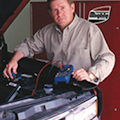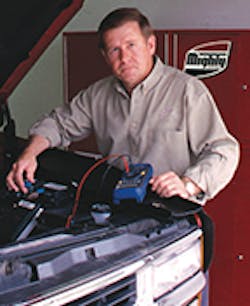The quality of a brake service is dependent upon the technician performing the proper service procedures and the quality of the friction installed on the vehicle. Fudge on either and the result is an unhappy customer. Most likely, you will be doing the brake job over — this time for free. Assuming you are familiar with all the mechanical steps and procedures necessary to perform a complete brake service, are you up to speed on friction formulations and some manufacturing procedures that make for a better brake job?
Friction Formulation
The selection of a friction formulation is a challenge for the brake engineers and chemists. They must comply with governmental regulations, technical issues, friction stability and coefficiency, maintaining vehicle control during braking, extreme operating temperatures, pedal effort requirements, friction and rotor wear, dusting, resistance to moisture, noise level and required stopping distance. Obviously, one friction formulation is not going to satisfy all concerns for every application, even though some installers attempt to achieve that. Are you performing the proper brake service procedures or just installing a set of friction and hoping for the best? What is the quality of the friction being installed? Follow the vehicle manufacturer’s friction recommendation for any given vehicle, as one friction will not be compatible with all applications.Friction Cocktail And Post Curing
A friction formulation is comprised of many ingredients referred to as a cocktail, all of which are held together by adhesives and resin binders. Quality friction manufacturers put their friction through a process referred to as post curing, which is a heat-treating process to help remove the uncured resin. The process greatly improves the pedal sensation following a brake job. While this process improves the initial pedal feel, a procedure referred to as burnish break-in has also been recommended by the friction suppliers and vehicle manufacturers. The procedure will assist in the curing process and prevent overheating of the friction, resulting in the adhesives and resin binders flowing to the surface of the pad, forming a glassy finish. When this occurs, brake noise, pedal fade and excessive pedal effort will result. The burnish break-in involves 10-15 stops from 30 mph. Read on for some advanced manufacturing techniques.Improved Pedal Feel
Original equipment friction manufacturers utilize two manufacturing procedures that can greatly reduce customer complaints and improve pedal sensation immediately following a brake service:- Positive Mold Process: Manufacturing process whereby a single punch is driven into a mold cavity applying direct pressure onto the friction formulation. Unlike other brake pad manufacturing processes, this procedure enables the friction engineers to vary the amount of compressibility a brake pad will have, affecting the ability of the pad to dissipate heat and absorb vibration. The application of even pressure ensures consistent density of the friction formulation and bonding to the backing plate. This process requires less resin in the formula. The resin is the bonding agent that holds the raw materials together. A low concentration of resin will improve pedal feel and reduce pedal fade. This manufacturing process promotes consistent friction material density within the pad, resulting in improved wear and performance for the life of the pad.
- Scorching: A process whereby the friction surface of the pad is super-heated by infrared radiation heat to remove uncured bonding agents on or near the pad surface. This process minimizes the initial break-in period and reduces noise due to pad glazing. Further, it conditions the friction material, thereby improving the friction level for the life of the pad. The performance of the friction is enhanced beyond that achieved with post curing alone. Scorching stabilizes the friction levels, raises the cold effectiveness and improves the performance of the pads across the entire operating range. Post curing and burnishing are not to be considered equal to the scorching process.
About the Author

Larry Hammer
Larry Hammer is an automotive troubleshooter who oversees Mighty's Technical Support Services in Jackson, Tennessee. Hammer has been writing technical articles since 1982. He may be reached at: [email protected]
Sign up for our eNewsletters
Get the latest news and updates
